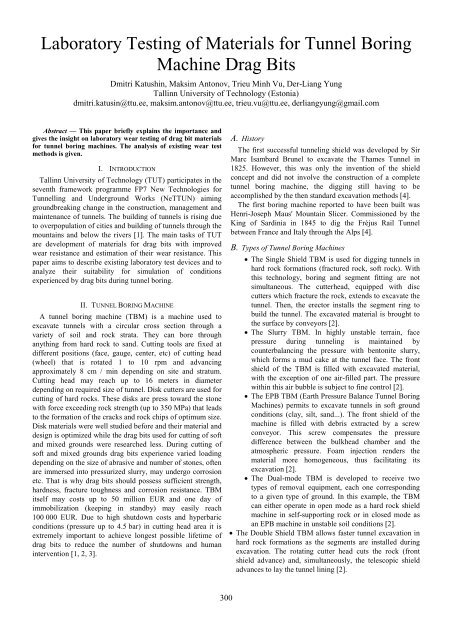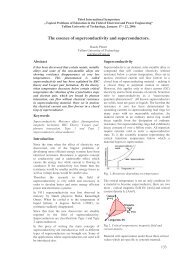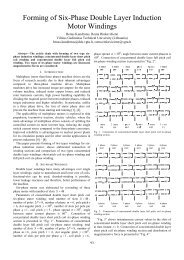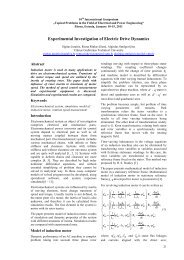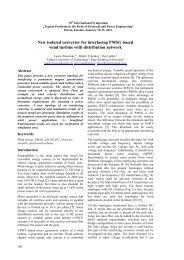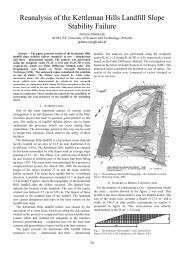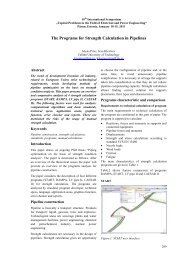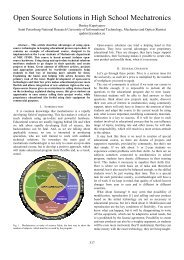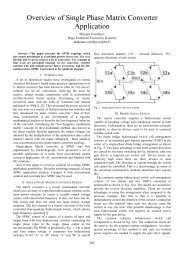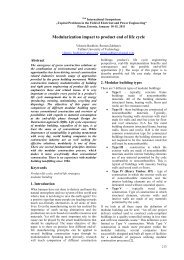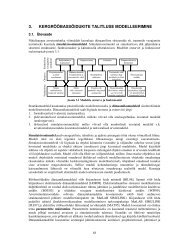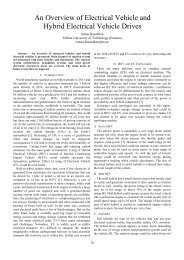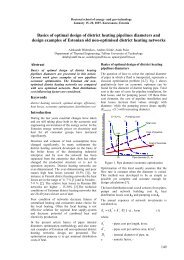Laboratory Testing of Materials for Tunnel Boring Machine Drag Bits
Laboratory Testing of Materials for Tunnel Boring Machine Drag Bits
Laboratory Testing of Materials for Tunnel Boring Machine Drag Bits
- No tags were found...
Create successful ePaper yourself
Turn your PDF publications into a flip-book with our unique Google optimized e-Paper software.
<strong>Laboratory</strong> <strong>Testing</strong> <strong>of</strong> <strong>Materials</strong> <strong>for</strong> <strong>Tunnel</strong> <strong>Boring</strong><strong>Machine</strong> <strong>Drag</strong> <strong>Bits</strong>Dmitri Katushin, Maksim Antonov, Trieu Minh Vu, Der-Liang YungTallinn University <strong>of</strong> Technology (Estonia)dmitri.katusin@ttu.ee, maksim.antonov@ttu.ee, trieu.vu@ttu.ee, derliangyung@gmail.comAbstract — This paper briefly explains the importance andgives the insight on laboratory wear testing <strong>of</strong> drag bit materials<strong>for</strong> tunnel boring machines. The analysis <strong>of</strong> existing wear testmethods is given.I. INTRODUCTIONTallinn University <strong>of</strong> Technology (TUT) participates in theseventh framework programme FP7 New Technologies <strong>for</strong><strong>Tunnel</strong>ling and Underground Works (NeTTUN) aiminggroundbreaking change in the construction, management andmaintenance <strong>of</strong> tunnels. The building <strong>of</strong> tunnels is rising dueto overpopulation <strong>of</strong> cities and building <strong>of</strong> tunnels through themountains and below the rivers [1]. The main tasks <strong>of</strong> TUTare development <strong>of</strong> materials <strong>for</strong> drag bits with improvedwear resistance and estimation <strong>of</strong> their wear resistance. Thispaper aims to describe existing laboratory test devices and toanalyze their suitability <strong>for</strong> simulation <strong>of</strong> conditionsexperienced by drag bits during tunnel boring.II. TUNNEL BORING MACHINEA tunnel boring machine (TBM) is a machine used toexcavate tunnels with a circular cross section through avariety <strong>of</strong> soil and rock strata. They can bore throughanything from hard rock to sand. Cutting tools are fixed atdifferent positions (face, gauge, center, etc) <strong>of</strong> cutting head(wheel) that is rotated 1 to 10 rpm and advancingapproximately 8 cm / min depending on site and stratum.Cutting head may reach up to 16 meters in diameterdepending on required size <strong>of</strong> tunnel. Disk cutters are used <strong>for</strong>cutting <strong>of</strong> hard rocks. These disks are press toward the stonewith <strong>for</strong>ce exceeding rock strength (up to 350 MPa) that leadsto the <strong>for</strong>mation <strong>of</strong> the cracks and rock chips <strong>of</strong> optimum size.Disk materials were well studied be<strong>for</strong>e and their material anddesign is optimized while the drag bits used <strong>for</strong> cutting <strong>of</strong> s<strong>of</strong>tand mixed grounds were researched less. During cutting <strong>of</strong>s<strong>of</strong>t and mixed grounds drag bits experience varied loadingdepending on the size <strong>of</strong> abrasive and number <strong>of</strong> stones, <strong>of</strong>tenare immersed into pressurized slurry, may undergo corrosionetc. That is why drag bits should possess sufficient strength,hardness, fracture toughness and corrosion resistance. TBMitself may costs up to 50 million EUR and one day <strong>of</strong>immobilization (keeping in standby) may easily reach100 000 EUR. Due to high shutdown costs and hyperbaricconditions (pressure up to 4.5 bar) in cutting head area it isextremely important to achieve longest possible lifetime <strong>of</strong>drag bits to reduce the number <strong>of</strong> shutdowns and humanintervention [1, 2, 3].A. HistoryThe first successful tunneling shield was developed by SirMarc Isambard Brunel to excavate the Thames <strong>Tunnel</strong> in1825. However, this was only the invention <strong>of</strong> the shieldconcept and did not involve the construction <strong>of</strong> a completetunnel boring machine, the digging still having to beaccomplished by the then standard excavation methods [4].The first boring machine reported to have been built wasHenri-Joseph Maus' Mountain Slicer. Commissioned by theKing <strong>of</strong> Sardinia in 1845 to dig the Fréjus Rail <strong>Tunnel</strong>between France and Italy through the Alps [4].B. Types <strong>of</strong> <strong>Tunnel</strong> <strong>Boring</strong> <strong>Machine</strong>s• The Single Shield TBM is used <strong>for</strong> digging tunnels inhard rock <strong>for</strong>mations (fractured rock, s<strong>of</strong>t rock). Withthis technology, boring and segment fitting are notsimultaneous. The cutterhead, equipped with disccutters which fracture the rock, extends to excavate thetunnel. Then, the erector installs the segment ring tobuild the tunnel. The excavated material is brought tothe surface by conveyors [2].• The Slurry TBM. In highly unstable terrain, facepressure during tunneling is maintained bycounterbalancing the pressure with bentonite slurry,which <strong>for</strong>ms a mud cake at the tunnel face. The frontshield <strong>of</strong> the TBM is filled with excavated material,with the exception <strong>of</strong> one air-filled part. The pressurewithin this air bubble is subject to fine control [2].• The EPB TBM (Earth Pressure Balance <strong>Tunnel</strong> <strong>Boring</strong><strong>Machine</strong>s) permits to excavate tunnels in s<strong>of</strong>t groundconditions (clay, silt, sand...). The front shield <strong>of</strong> themachine is filled with debris extracted by a screwconveyor. This screw compensates the pressuredifference between the bulkhead chamber and theatmospheric pressure. Foam injection renders thematerial more homogeneous, thus facilitating itsexcavation [2].• The Dual-mode TBM is developed to receive twotypes <strong>of</strong> removal equipment, each one correspondingto a given type <strong>of</strong> ground. In this example, the TBMcan either operate in open mode as a hard rock shieldmachine in self-supporting rock or in closed mode asan EPB machine in unstable soil conditions [2].• The Double Shield TBM allows faster tunnel excavation inhard rock <strong>for</strong>mations as the segments are installed duringexcavation. The rotating cutter head cuts the rock (frontshield advance) and, simultaneously, the telescopic shieldadvances to lay the tunnel lining [2].300
III. DRAG BIT MATERIALThe part <strong>of</strong> the drag bit that is subjected to toughest wearconditions is usually made <strong>of</strong> ceramic-metal (cermet)composite material. Conventionally it is cermet made <strong>of</strong>tungsten carbide and cobalt (WC-Co). Cobalt content usuallyranges from 6 to 15 % by weight. WC grain size is rangingfrom 2 to 20 µm. Any excess or deficiency <strong>of</strong> carbon hassignificant effect on hardness and strength. In general, anyalloying impurities like iron chromite, nickel, sodium orsulphur can result in poor combination <strong>of</strong> hardness andstrength. Small additions <strong>of</strong> titanium carbide (3 – 5% byweight), however, could prevent grain coarsening andincrease hardness without affecting the transverse rupturestrength. Equally important is the grain size control; hardnessand compressive strength increasing with decreasing grainsize, whereas the desirable grain size <strong>for</strong> best rupture strengthis from 1µm to 3 µm. Porosity in the alloys’ structure is anunwanted parameter. High porosity gives rise to poortransverse rupture strength but in hard metals, high densitiesup to 99.5% are achieved and uni<strong>for</strong>mly distributed porosityis usually present, which is not so harmful [5, 6].Improvement <strong>of</strong> wear resistance <strong>of</strong> WC-Co cermets isachievable by combining the coarse and fine carbides in onestructure, so that the smaller ones fill the spaces between thelarger ones. Double-structuring may help to improve fracturetoughness. Development <strong>of</strong> complex structures with improvedwear resistance is possible by additions <strong>of</strong> different hardphase types (Cr 3 C 2 , TiC, VC, TaC, NbC, etc.). Resistance tocorrosive environments and thermal shocks may be improvedby modification <strong>of</strong> binder phase by Ni, Cr, Re, etc [5, 7].As far as abrasive wear is concerned polycrystallinediamond compact (PDC) tools are now available with 5-6times higher hardness than tungsten carbide. However, PDCis more susceptible to brittle failure than cemented tungstencarbide, because its fracture toughness is almost twice lowerthan that <strong>of</strong> tungsten carbide with 6% cobalt [5].Fig. 1. Multi Modular Tribosystem with adjustable inertia and rigidity <strong>of</strong>loading system (MMTS) <strong>for</strong> Block-on-Ring abrasive wear testing (TUT).Abrasive is supplied between disk and sample. It is usuallydry abrasive but spraying <strong>of</strong> liquid onto abrasive after nozzleis possible. Sample may be heated or cooled to provideconstant temperature from 10 to 450 ºC. If testing with slurryis required then it is possible to make tests similar to ASTMG 105 or B 611 standards (Fig. 2). Usually abrasive <strong>of</strong> sizesmaller than 1 mm are used. These are one sample tests.Fig. 2. Device <strong>for</strong> abrasive wear testing with slurry (TUT).Ultra-low stress abrasion used <strong>for</strong> evaluation <strong>of</strong> the wearproperties <strong>of</strong> oxide scales at elevated temperatures is given inFig. 3. The load is generated only due to immersion into theabrasive. Up to 36 samples may be treated simultaneously intwo abrasives.IV. LABORATORY DEVICES FOR DRAG BIT WEAR TESTINGWITH FREE ABRASIVEIt is possible to make testing applying fixed (<strong>for</strong> exampleagainst sand paper that is called two-body abrasion) or againstfree abrasive. When free abrasive is present between twobodies the test is called three-body abrasion.A. <strong>Testing</strong> in Conditions <strong>of</strong> Ultra-Low. Low or High StressAbrasion<strong>Testing</strong> in Block-on-Ring configuration may be per<strong>for</strong>medusing rubber-coated (according to ASTM G 65 standard) orsolid steel ring. During testing using rubber wheel theabrasive is usually not broken and it is called low-stressabrasion. Multi Modular Tribosystem (Fig. 1) allows testingusing both wheels while enabling to adjust rigidity and inertia<strong>of</strong> loading system that is required to make test conditions asclose as possible to those experienced in real applications.Fig. 3. Device <strong>for</strong> ultra-low stress abrasion-oxidation testing at elevatedtemperatures (TUT).B. <strong>Testing</strong> in Conditions <strong>of</strong> Impact by Abrasive <strong>of</strong> DifferentSizeIn dry erosion test the specimen is attacked by the jet <strong>of</strong>particles that is accelerated by means <strong>of</strong> centrifugal <strong>for</strong>cesduring the rotation <strong>of</strong> the rotor (Fig. 4). It is possible to varythe impact angle (10º-90º), impact speed (0-80 m/s) andtemperature (20-650ºC in elevated erosion test device). Up to20 samples are tested simultaneously. Similar principle isused in centrifugal type slurry erosion tester (Fig. 5) thatallows to attack samples by the jet <strong>of</strong> slurry that is the mixture<strong>of</strong> abrasive and liquid. The slurry may not be changed during301
test. Both methods do not allow using abrasive larger than1mm. Up to 30 samples may be treated simultaneously.Fig. 4. Dry abrasive erosion test device CAK (TUT).Fig. 5. Centrifugal type slurry erosion tester (TUT).Larger stones (up to 25 and up to 10 mm in impeller-typeand in disintegrator devices accordingly) may be usedapplying impeller [8] or in disintegrator type impact testdevices. Disintegrator allows speeds up to 200 m/s while inimpeller-type device it is below 10 m/s. Edges are notprotected in impeller-type device that intensify the edge effect(edges are usually worn first and the wear rate depends onradius <strong>of</strong> the edge).Fig. 8. NTNU device <strong>for</strong> dry abrasion testing with abrasive <strong>of</strong> mixed sizes[9].In [10] and [11] the sample is moved up and down togenerate impact. During high temperature cyclic impactabrasion test the plunger impact the specimen and then slideproviding high stress abrasion. The volume removed <strong>for</strong>mzones <strong>of</strong> impact and abrasion are measured and wear rates inthese both conditions could be estimated.Fig. 6. Impeller-in-drum impact-abrasive wear tester [8].Fig. 9. Three-body pin-on-disk device [10].Fig. 7 Disintegrator type impact wear tester (TUT).C. <strong>Testing</strong> in Combined Conditions <strong>of</strong> Impact and AbrasionIn [9] it is proposed to use abrasive <strong>of</strong> mixed size to addimpact conditions (Fig. 8). The test is similar to Block-on-Ring abrasive wear testing while it has speed limitation. Anadvantage is that the sample is tested with fresh abrasivehowever abrasive removal by vacuum cleaner may result inhigh wear rate <strong>of</strong> removal system.Fig. 10. High temperature cyclic impact abrasion [11].The soil abrasion testing system proposed in [12] is theonly system alloying to make tests under different pressure(0-10 bar). The samples are rotated inside the slurry. Thetorque required to provide rotation is measured. The edges <strong>of</strong>302
samples are protected to avoid edge effect. It is not possibleto change abrasive during test.Fig. 11. Pennstate soil abrasion testing device [12].D. Comparison <strong>of</strong> Tribodevices.In order to evaluate the suitability <strong>of</strong> devices <strong>for</strong>estimation <strong>of</strong> the wear resistance <strong>of</strong> tunnel boring machinedrag bits they are compared in Table 1.Table 1. Comparison <strong>of</strong> laboratory tribodevice’ suitability <strong>for</strong> simulation <strong>of</strong>drag bit wear conditionsDevice vs test conditionsMMTS <strong>for</strong> Block-on-Ringabrasive wear testing (Fig. 1)Slurry abrasive wear testing(Fig. 2)Ultra-low load abrasionoxidation(Fig. 3)ImpactHigh stressFresh abrasiveWetting <strong>of</strong> abrasivePressurized chamberControllable rigidityand inertiaAvailable in TUT- + + + - + +- + - + - - +- - - - - - +Dry erosion (Fig. 4) + - + - - - +Slurry erosion(Fig. 5)- - - + - - +Impeller-in-drum (Fig. 6) + + - - - - -Disintegrator (Fig. 7) + + + + - - +NTNU (Fig. 8) + + + - - - -Three-body pin-on-diskdevice (Fig. 9)High temperature cyclicimpact abrasion (Fig. 10)Pennstate soil abrasiontesting device (Fig. 11)+ + - + - - -+ + + - - - -- + - + + - -V. CONCLUSIONSIt is rather impossible <strong>for</strong> single laboratory tribodevice toreplicate all conditions characteristic <strong>for</strong> wear <strong>of</strong> drag bits <strong>of</strong>real tunnel boring machine. It is usually recommended tostudy separate wear processes since it allows better controlover the process. By providing the MMTS with smart loading,abrasive feeding and sample rotation systems it is possible tosimulate real conditions as close as possible.ACKNOWLEDGMENTThe authors would like to thank “New Technologies <strong>for</strong><strong>Tunnel</strong>ling and Underground Works” project (NeTTUN; FP7NMP.2011.4.0-2; Grant agreement 280712) financed byEuropean Commission, Doctoral Studies andInternationalisation Programme “DoRa”, Estonian Ministry<strong>of</strong> Education and Research (Project SF0140113Bs08) andEuropean Social Fund (Project "Doctoral School <strong>of</strong> Energyand Geotechnology II) <strong>for</strong> financial support <strong>of</strong> this study.REFERENCES[1] Gernot Beer. „Technology innovation in underground construction”, Ed.CRC Press, 2009.[2] “Underground work” – in<strong>for</strong>mation from NFM-Technologies web-page,http://www.nfm-technologies.com/-Underground-work-.html, accessedon-line, 20.11.2012.[3] M. Spencer, A. Stolfa, E. Bentz, S. Cross, C. Blueckert, J. Forder, W.London, H. Wannick, B. Guggisberg R. Gallagher. „<strong>Tunnel</strong> <strong>Boring</strong><strong>Machine</strong>s." IMIA Working Group Paper WGP 60 (09).[4] Bagust, Harold (2006). „The greater genius? a biography <strong>of</strong> MarcIsambard Brunel.” Ian Allan Publishing. p. 65.[5] S. T. A. Gillani, N. Butt. „Excavation Technology <strong>for</strong> Hard Rock -Problems and Prospects.” Pak. J. Engg. & Appl. Sci. Vol. 4, Jan 2009 p.24-33.[6] „Cemented Carbide, Sandvik new developments and applications.”Available online[7] K.Brookes. „Looking again at large grains in hardmetal tools. MetalPowder Report.” Elsevier. 2006.[8] R.D. Wilson, J.A. Hawk. „Impeller wear impact-abrasive wear test.”Wear 225–229 1999 1248–1257.[9] B. Nilsen, F.Dahl, J.Holzhäuser, P.Raleigh (2007). „New TestMethodology <strong>for</strong> Estimating the Abrasiveness <strong>of</strong> Soils <strong>for</strong> TBM<strong>Tunnel</strong>ing. Proceedings <strong>of</strong> Rapid Excavation and <strong>Tunnel</strong>ingConference”, Society <strong>for</strong> Mining, Metallurgy, and Exploration Inc.,2007, p.104-116[10] J. Tervaa, T. Teeri, V. Kuokkala, P. Siitonen, J. Liimatainen, „Abrasivewear <strong>of</strong> steel against gravel with different rock–steel combinations,Wear”, 267 (2009) 1821–1831[11] A. Zikin, M.Antonov, I.Hussainova, L.Katona, A.Gavrilovic´„High temperature wear <strong>of</strong> cermet particle rein<strong>for</strong>ced NiCrBSihardfacings.” http://dx.doi.org/10.1016/j.triboint.2012.08.013[12] J. Rostami, E. A. Gharahbagh, A. M. Palomino, M. Mosleh (2011)„Development <strong>of</strong> Soil Abrasively <strong>Testing</strong> <strong>for</strong> S<strong>of</strong>t Ground <strong>Tunnel</strong>ingusing Shield <strong>Machine</strong>s. <strong>Tunnel</strong>ling and Underground SpaceTechnology,” 2012 p. 246-256303


